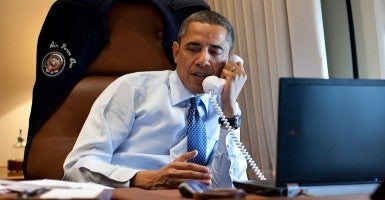Foreign affairs may not have played a big part in the midterm elections, but that doesn’t mean all is well with current foreign policy. A CBS poll the week before the election found only 34 percent of Americans approved of the president’s handling of foreign policy. Within our foreign policy establishment, there is widespread bipartisan unease about his inability to handle crises that seem to be spiraling out of control.
What should be done differently? In a series of articles on ForeignPolicy.com, we outline an alternative strategy. The key changes that should be made are:
• Reinvigorate international economic policy. Economics topped the issues in the midterm elections; so too should international economics be central to a global foreign policy strategy. This means moving quickly on the Trans-Pacific Partnership (TPP) and the Transatlantic Trade and Investment Partnership (TTIP) and ensuring they actually advance free markets and liberalize trade. It means approving the Keystone XL pipeline and promoting a North America-wide energy initiative that would improve diplomatic relations while taking full advantage of the shale revolution and Mexico’s energy sector liberalization. It means also easing restrictions on petroleum and natural gas exports.
• Restore deterrence and peace through strength as strategic principles. The first purpose of military strength is to deter wars and, if that fails, to win them. We aren’t interested in a “fair fight” with enemies, but in possessing overwhelming strength so no one chooses to challenge us. To do that, we must restore our defense budget — at a minimum — to pre-sequester levels.
• Regain the initiative in the war on terrorists. By focusing only on “core” al Qaeda, the administration let the terrorist threat metastasize, proliferate and escalate. We need a much more proactive and comprehensive approach. Counterterrorism has many facets, but ultimately it is a kind of warfare, not merely law enforcement, and it’s perilous to ignore its ideological and public diplomacy dimensions. Preventing key failed states from emerging as safe havens for terrorists is also crucial.
• Repair and strengthen our alliances. The “lead from behind” strategy has clearly failed. We should be working closely with our allies, not criticizing or questioning them in public. We should bolster our military forces in Europe, restore old friendships in the Middle East and elsewhere, and deploy more military resources to back up the president’s rhetorical commitment to Asia.
• Reintegrate economic growth and political progress for weak and failing states. Failing states are growing threats to American security and global order. Much of what causes states to fail are dysfunctional economic policies and poor governance. We can help them liberalize their economies, practice the rule of law, combat corruption and crony capitalism, embrace financial transparency, support free trade and open foreign investment policies, and liberalize labor regulations. We can also help them make greater progress toward stable democratic governments. It’s not about “nation building” or “spreading democracy.” It’s a matter of helping civil societies and potentially friendly governments become more stable U.S. partners.
• Recover our ability to work with regional forces. It is clear that our ability to work with regional forces like the Syrian rebels is less than it should be. It’s not just a diplomatic problem; it’s a capacity and skills problem. We succeeded in the past — in providing arms and other assistance in Colombia’s war on the FARC guerrillas, for example. To succeed again we must do a better job of vetting, training and coordinating regional groups. We also must enhance the capabilities of our conventional and special operations forces to provide better support.
To re-engage as a world leader, the U.S. must relearn the value of strength and deterrence as strategic principles. Our motto should be: Don’t rise up quickly in anger, but be resolute in seeing a chosen right to a successful end. Back allies, don’t undermine them. And, through vigorous U.S. leadership, do everything possible to shape the world’s economy and political structures to enable peace and prosperity for all.
Originally appeared in the Washington Times.






























